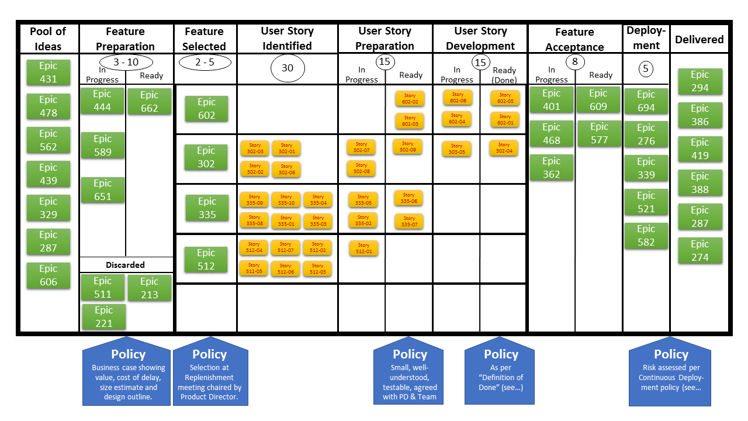La pratica generale ‘Visualizza’ del metodo Kanban, permette di rendere visibili tutti gli aspetti del lavoro: il sistema di gestione del lavoro, le policy, gli assunti, le linee guida e i vincoli sottostanti, nonché il lavoro stesso. Le Kanban board visualizzano le voci di lavoro in corso, in attesa di essere elaborate, bloccate, in attesa di altri o in ritardo sulle scadenze. Queste informazioni sullo stato del lavoro sono importanti per prendere decisioni corrette relativamente al lavoro. Allo stesso modo, la visualizzazione delle politiche di gestione del lavoro, come i criteri di ready-to-start e done e i criteri di triage, è fondamentale per comprendere il processo e sviluppare la capacità di migliorare e adattarsi ai cambiamenti del contesto aziendale.
Come funziona la pratica ‘Visualizza’ in Kanban
A differenza quindi di quanto si pensa comunemente, le Kanban board non si limitano a rappresentare il flusso di lavoro in modo generico, ma riportano molti altri elementi:
- le richieste di lavoro – rappresentate da schede cartacee o elettroniche – e il loro stato
- il flusso di lavoro
- i rischi associati al lavoro
- le aspettative del cliente e degli altri stakeholder per il lavoro
- le classi di servizio
- le tipologie di elementi di lavoro
- le policy utilizzate per la gestione del lavoro
- chi sta svolgendo il lavoro e con chi sta collaborando
Per i beni immateriali o i servizi professionali, l’obiettivo è quello di utilizzare la visualizzazione per abilitare molte delle stesse tecniche di gestione che sono normalmente utilizzate nelle industrie di produzione dei beni fisici.

Esempio pratico
Immaginiamo di essere all’interno di un team di sviluppo software che utilizza il metodo Kanban per gestire i progetti e che il team stia lavorando a un progetto per implementare nuove funzionalità in un’applicazione mobile. Le attività includono:
- Progettare l’interfaccia utente.
- Sviluppare il backend per la gestione dei dati.
- Scrivere i test automatici per garantire la qualità del codice.
Ogni attività è rappresentata da una scheda che si muove lungo il flusso di lavoro. Supponiamo ad esempio, che uno sviluppatore identifichi un rischio relativo all’interfaccia utente: la scheda “Progettare interfaccia utente” sarà contrassegnata da un indicatore di rischio. Questa visibilità permette al team e al project manager di vedere in tempo reale la segnalazione relativa all’attività e prendere decisioni tempestive per gestire il rischio stesso.
Benefici derivanti dall’applicazione della pratica ‘Visualizza’
- Rendere visibile ciò che è invisibile.
- Assicurare una comunicazione chiara e corretta delle informazioni sulle richieste di lavoro.
- Ridurre il sovraccarico di lavoro, visualizzando e limitando il lavoro in corso alla capacità produttiva effettiva del sistema kanban.
- Sviluppare una comprensione condivisa degli obiettivi, dello stato del lavoro, degli impedimenti e dei rischi.
- Catturare i rischi aziendali significativi associati alle richieste di lavoro.
- Facilitare un processo decisionale tempestivo e coerente, la collaborazione e la condivisione delle conoscenze.
- Sviluppare la fiducia nel sistema di lavoro.
- Ridurre le interruzioni.
- Spostare l’attenzione dal lavoratore al lavoro.
La pratica ‘Visualizza’ per limitare i bias cognitivi
La pratica ‘Visualizza’ del metodo Kanban aiuta anche a limitare gli effetti dei bias cognitivi, in particolare dell’euristica della disponibilità, un fenomeno descritto da Daniel Kahneman e Amos Tversky secondo cui le persone tendono a sovrastimare l’importanza delle informazioni più facilmente accessibili o recenti nella loro memoria. Questo bias può portare a decisioni distorte, soprattutto in ambienti complessi, dove alcune attività o problemi più “visibili” ricevono attenzione sproporzionata rispetto a quelli meno evidenti.
Con la visualizzazione del sistema di lavoro su una Kanban board secondo quanto sopra descritto, tutte le informazioni rilevanti sono rappresentate in modo chiaro e tangibile, riducendo l’influenza delle impressioni soggettive e delle informazioni parziali. La Kanban board fornisce una visione oggettiva dello stato del lavoro, evitando che il team si concentri solo su situazioni più evidenti o recenti. Questo approccio permette una gestione più bilanciata, equa e razionale delle decisioni, migliorando la risoluzione dei problemi in modo strategico.
Conclusione
La pratica ‘Visualizza’ nel metodo Kanban è quindi un potente strumento per migliorare la gestione dei flussi di lavoro e ottimizzare la produttività. Attraverso una chiara visualizzazione del sistema di lavoro, i team possono ottenere una maggiore trasparenza, prendere decisioni corrette e promuovere la collaborazione. L’adozione di questo approccio non solo semplifica la gestione quotidiana del lavoro, ma crea anche un ambiente di lavoro più efficiente e reattivo alle esigenze in evoluzione.
Ho pubblicato originariamente questo articolo per il portale Kanban Help, al quale collaboro insieme al collega Luca Gambetti.
Visita Kanban Help – www.kanban.help – per conoscere gli strumenti formativi e di coaching che ti possono aiutare a introdurre il metodo Kanban nella tua azienda.









